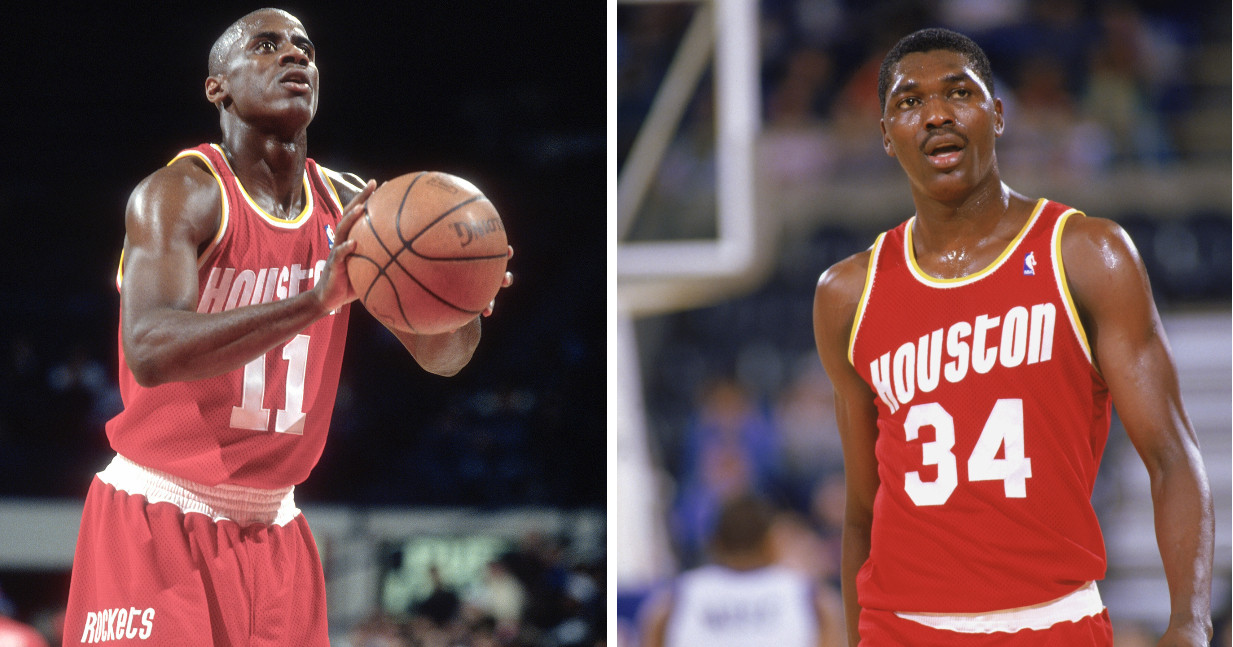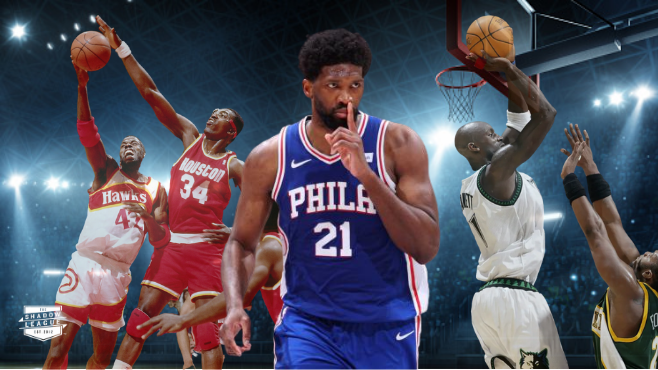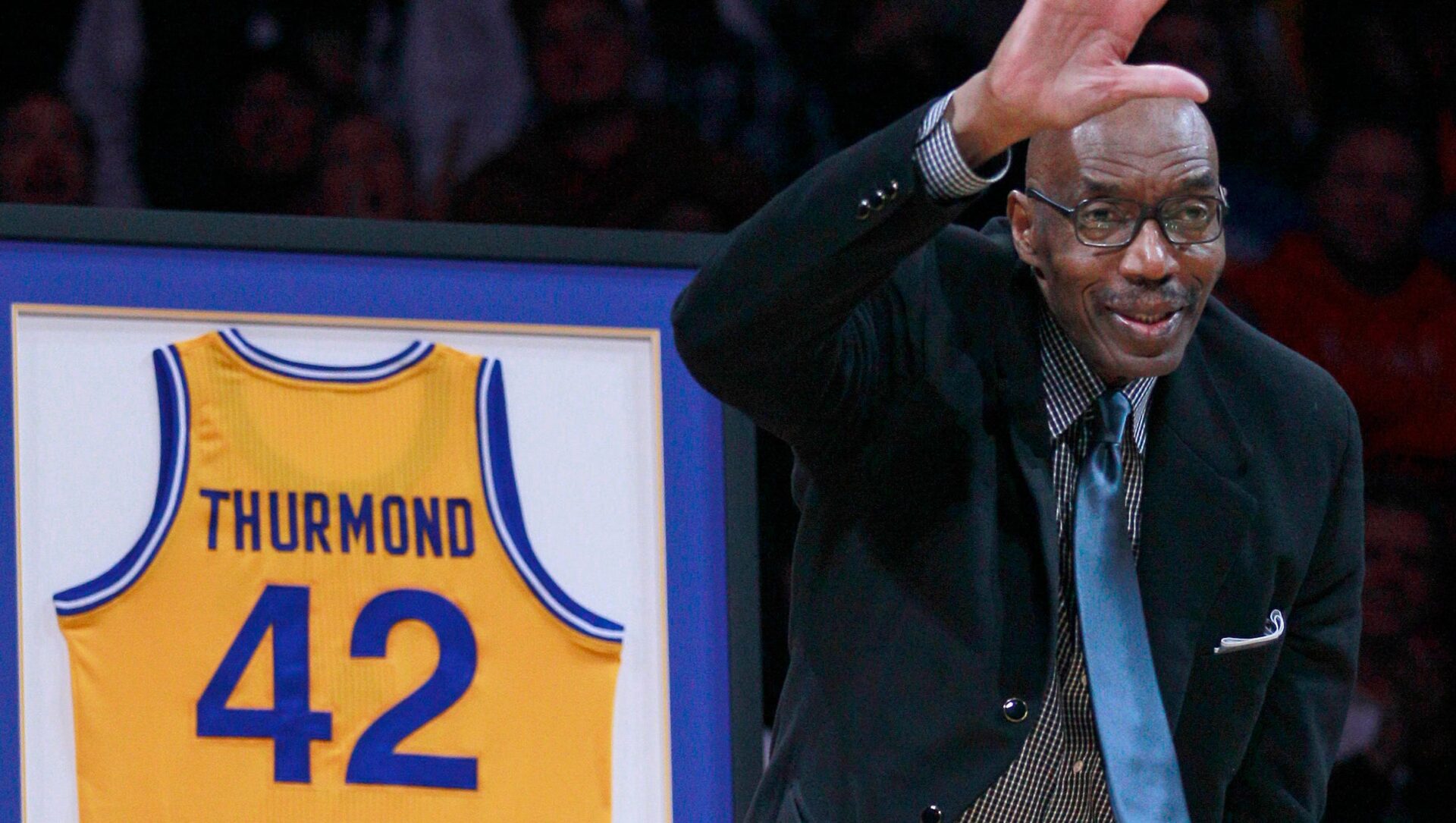Names like Nnamdi Asomugha, Serge Ibaka, Osi Umenyiora, and Bismack Biyombo still challenge spell check, yet roll off the tongue of the American sports fan. The globalization of markets and cultures has many players from the African continent filling NBA and NFL rosters. How did we get here? Fate, fluke and failure. Let us explain…
**********
Once upon a time, a dream and a nightmare brought the African-born athlete to the NBA and NFL when Hakeem ‘The Dream’ Olajuwon and Christian ‘ The Nigerian Nightmare’ Okoye arrived from the Motherland to the Home of the Brave.
At age 15, Olajuwon was in high school at the Muslim Teachers College in Lagos, Nigeria playing soccer (goalkeeper) and handball. But a fellow student persuaded the coaches and Olajuwon to play basketball. A star was not yet born, but he was in utero.
Two years later, the 6-10 (then named) Akeem Abdul Olajuwon was dream-shaking his way to leading the University of Houston to the brink of a national championship. He would later drop Abdul and revert back to his name’s original spelling of Hakeem. Similarly, the school’s official nickname was the Cougars, but was hijacked when it became known as the basketball fraternity of Phi Slamma Jamma. Olajuwon was the leader and Clyde Drexler was his right-hand man. But three consecutive trips to the Final Four came up nathan.
In the 1982 semifinals, Olajuwon, as a freshman, and Drexler lost to North Carolina led by James Worthy and Michael Jordan. The next year, the Cougars played Louisville in the semifinals in what many considered the de facto championship. The game was like Tupac & Leon – “Above the Rim” – with the Cougars winning. But, two nights later, NC State defeated Houston on a Lorenzo Charles put-back dunk. One year later, the Cougars lost again in the finals, this time to Patrick Ewing-led Georgetown.
Olajuwon was then picked No.1 by his adopted hometown Houston Rockets in the famous 1984 NBA Draft. Ten years later his footwork, head and ball fakes marinated into a “Dream Shake,” and he led the Rockets to back-to-back NBA titles in en route to the Hall of Fame.
Soon after Olajuwon arrived in Houston, Christian Okoye, from the city of Enugu, Nigeria began attending Azuza Pacific University in Southern California. As a standout track and field athlete in the shot-put, discuss and hammer throw, Okoye had Olympic aspirations to compete for his native Nigeria.
However, after his hopes were dashed when he was not selected to be a part of the team for the 1984 Los Angeles Games, his friends encouraged him to try football. Although he did not particularly enjoy the game, it only took a few weeks, with his 6-1, 260 pound chiseled frame and sprinter–like speed, for him to dominate the Division II level.
He was drafted in the second round of the 1987 NFL Draft by the Kansas City Chiefs, and led the league in rushing in 1989 with 1,480 yards, while being named to the first of his two Pro Bowls. His crushing runs were immortalized in the primitive video game Tecmo Bowl. Okoye played until 1992 but was hampered by injuries including a neck and spinal cord issue that forced him to wear those bulging shoulder pads to keep his head immobile.
Now, thirty years after Olajuwon and Okoye entered our highlight reel, who/what is the African athlete in America?
**********
Basketball is a simple game but it ain’t easy. There were many attempts to locate a seven-footer in Africa, add water and produce a bona fide big-man. There was some degree of success with Manute Bol from Sudan and more with the defensive-minded Dikembe Mutombo from the Democratic Republic of Congo (formerly Zaire). But there were also some outright failures. Another Nigerian, Yinka Dare, was out of the league in a few years after being drafted by the New Jersey Nets in 1993. Another bust was the Nigerian-British player Michael Olowakandi selected in 1998 with the No. 1 pick by the Los Angeles Clippers.
If US basketball scouts didn’t comb the Sub-Saharan to the Serengeti for players, Hollywood told us they did. Just before Olajuwon won his first NBA title in 1994, the film The Air Up There depicted the recruitment of a rural African villager, Saleh, to play college ball in the States. The film was another tale of the noble savage that evoked no similarities to people like Olajuwon, the product of a thriving metropolitan city with a population over 7 million and middle class family with a father who owned a cement business. Yet, the movie could not resist appropriating Olajuwon’s “Dream Shake” with the Jimmy Dolan (Kevin Bacon’s college coach character) “Shake-n-Bake” move that climaxes the movie.
But a little more than a decade after Olowokandi was drafted, things changed. By 2010, the new wave of African imports in the NBA was flourishing with players like Luol Deng, Thabo Sefolosha and Serge Ibaka. Ibaka, from Congo, is such a force that he made James Harden an unaffordable luxury item, forcing his trade to the Rockets.
However, Awasum Awasum II, founder of The African Sports Network Journal, who reports and blogs on the African sports scene, bemoans that many of the brightest African basketball stars are developed elsewhere. Notwithstanding Basketball without Borders, players, like Ibaka, are shepherded away to Europe to cultivate their game, Ibaka developed in Spain’s pro leagues and also plays internationally for that country.
“The NBA doesn’t really try to produce players from Africa,” said Awasum, a native of Cameroon while in his homeland preparing for the African Nations Cup. “They leave it up to the player and the teams in Europe to develop them, leaving many without the chance to succeed. True development would be done right here in Africa where a country could compete at the Olympics in basketball. But the issue is resources.”
**********
In contrast to basketball, football seems complex, but it can be learned relatively late in life compared to other sports (Okoye was 23 years-old before playing). Yet, it would be four years after Okoye left the NFL before another African-born player would impact the American gridiron.
Tshimanga “Tim” Biakabutuka born in Kinshasa, Zaire (Congo), became a star running back at the University of Michigan. Known as “Touchdown Tim,” he was drafted with the ninth overall selection in 1996 but played six injury-plagued seasons for the Carolina Panthers.
A decade after Biakabutuka left the NFL, there are many Africans playing American football. And approximately 70 percent of Africans in the NFL are of Nigerian descent such as B.J. Raji and Brian Orakpo. Nigeria is also the richest and most populous African nation (the capital, Lagos, has a population of almost 8 million, making it the “blackest” city in the world and the real Chocolate City).
But political developments caused the inevitability of this African presence. There has been a wave of African immigration to America over the last few decades through the Immigration and Nationality Act of 1965 repealing discriminatory national quotas and also the emergence of liberated African states. In essence, legislation and decolonization has brought the player to the game.
“The number of Nigerian players in the NFL is not about the wealth of Nigeria, but the country’s large number of immigrants to America,” said Awasum. “Other countries could and will produce players.”
African countries with similar high-immigration rates play show up on NFL rosters as well. A partial listing includes Joseph Addai, born in Houston of immigrants from Ghana. From Liberia, Mohamed Masaqoui, born in Charlotte and played at Georgia before being drafted by the Cleveland Browns. One exception might be Mathias Kiwanuka with Ugandan roots, born in Indianapolis, and the grandson of Benedicto Kiwanuka, the first prime minister of Uganda, who was assassinated by in 1972 by the dictator Idi Amin.
**********
Manute Bol, who died in 2010 after contacting a rare skin disease while helping to build a school and fighting election corruption in his native Sudan, may have added to his wide-ranging legacy that includes his great humor and stunts for charity with his son, Bol Bol. Standing a lanky 6-5, the seventh grader in Kansas has already drawn plenty of attention for his basketball exploits. The young Bol has been labeled as one of America’s most promising middle school hoopster with a game that includes three-point range, ball handling skills and pop’s shot-blocking talent.
Myck Kabongo, born in Lumbashi, Zaire (Congo) is a point guard at the University of Texas known for flash and the fundamental. Kabongo played at St. Benedict’s Prep in Newark, NJ before bolting to Findlay Prep in Nevada. But with assimilation apparently comes corruption. Targeted in a NCAA investigation, Kabongo was recently nailed with a season-ending suspension for taking impermissible benefits of $475 for expenses from Rich Paul (LeBron James’ agent) for a workout. However, after some backlash, the NCAA has reduced it to a 23 game suspension.
Then there is the remarkable story of the Uganda Little League team playing in the 2012 Little League World Series in Williamsport, Pa. The game of baseball was introduced in 2004 to Uganda, but has quickly gone from players with no shoes and shabby equipment to diamond gems. Uganda qualified for the 2011 LLWS but was denied the trip due to visa and age issues. But this past summer, the team from Lugazi arrived at Williamsport. Although the Ugandans lost two games before prevailing in a consolation game, 3-2, versus Gresham, Oregon, far more memorable was the spirit of the kids from Uganda.
As the story begins, so shall it continue? Three decades and one year ago our brothers were brought forth on this continent creating a new sports nation, conceived in liberty and dedicated to the proposition that all men could ball. Now, knowing the history of America, it goes without saying how much Africa involuntarily outsourced to the American sports nation. This time, thoutgh, it’s on the up-and-up.



